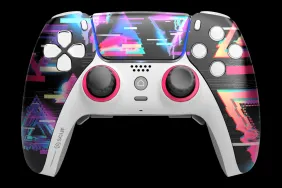High speed racing for the daily commute… now in amazing 3D!
Depth perception is a vital skill when driving. Without it, you’d have trouble riding the ass of the painfully slow driver in front of you. You wouldn’t be able to gauge the best time to give the bird to an oblivious pedestrian. And you could forget about ever pulling off an impressive Dukes of Hazard-style jump over Roscoe and Boss Hog’s heads.
[image1]As one of the privileged few titles launching with Nintendo’s 3DS, Ridge Racer 3D gets the chance to show off its three-dimensional chops and remind us all just how important depth perception is to driving. Sure, you could speed around in two dimensions—just like Superman could spend the rest of his life as Clark Kent—but that extra dimension is a potential game changer for the racing genre.
Unfortunately, the freshness and excitement of Ridge Racer 3D begins and ends there since its design and mechanics are about as cut and dry as an arcade racer gets. Choose a car, pick a race, and hit the tarmac. However, the upside to Ridge Racer’s straightforward presentation is that it’s easy to jump into and out of a race without worrying about a bunch of unnecessary menus, settings, and tunings.
Racing in Ridge Racer 3D is all about drifting to fill your nitrous meter, boosting whenever you can, and drafting behind opponents to slingshot past them. The new analog nub makes steering a much better fit than it would have been on the DS hardware, and the impressive 3D implementation makes it much easier to see distant opponents and to gauge upcoming curves than on any other handheld racing game.
[image2]The longer you play, the more you’ll notice that there aren’t many variations in the types of racing available. The only real variation is in how the races are packaged. Grand Prix arranges races in small clusters of events; place third or higher to progress to the next group of races, then place third or higher in that next group to progress even further, and so on. Courses begin repeating very quickly and the immense number of events only highlights how often you’ll be racing on the same tracks. Fortunately, because this is a handheld game, it isn’t designed to be played for long stretches at a time. It works great in short bursts, letting you progress one fifteen-minute bus ride at a time.
There are also custom multi-race events, but since these are virtually indistinguishable from the Grand Prix events, you may as well stick with those instead. Breaking the events even further apart, you can choose a single race with custom settings of your choosing. But, again, none of these presentations feels different enough from any other, and the addition of time trial racing doesn’t really play to Ridge Racer’s strengths.
Most races pit the player against seven AI opponents. Local competitive play against three human opponents is also available. The lack of online play is a surprise given the added online emphasis of the new handheld—especially compared to launch-day standouts like Super Street Fighter IV: 3D Edition. Playing alone is fun enough in short sessions, but Ridge Racer 3D doesn’t have enough variety or personality to keep it interesting for the long run. Knowing that an inevitable Mario Kart 3D will see release at some point down the line, Ridge Racer 3D is nothing more than a competent place-holder and proof of concept.
[image3]Nevertheless, seeing a racing game in glasses-free 3D is a wonder in and of itself. And it’s more than just a graphical novelty. The technology helps to distinguish track features and opponent cars that might otherwise go unnoticed on the small screen. And, unless you have a 3D-ready TV, a PS3, and a copy of Gran Turismo 5, there’s really nothing else quite like it.
Too bad, then, that the sense of depth doesn’t extend into Ridge Racer 3D’s other features. At its best—as speeds begin to escalate and as you begin to lock into that magical “zone”—Ridge Racer 3D begins to feel like a direct competitor to Wipeout, but all too often the grind of it all keeps it from pulling ahead the pack. The racing is solid, to be sure, but for a game that puts so much stock in its three-dimensional presentation, it’s a surprisingly flat experience.
-
3D adds unexpected visual acuity
-
Perfect for short-session play
-
Great at high speeds
-
Solid racing mechanics
-
Repetitive structure
-
No online play











